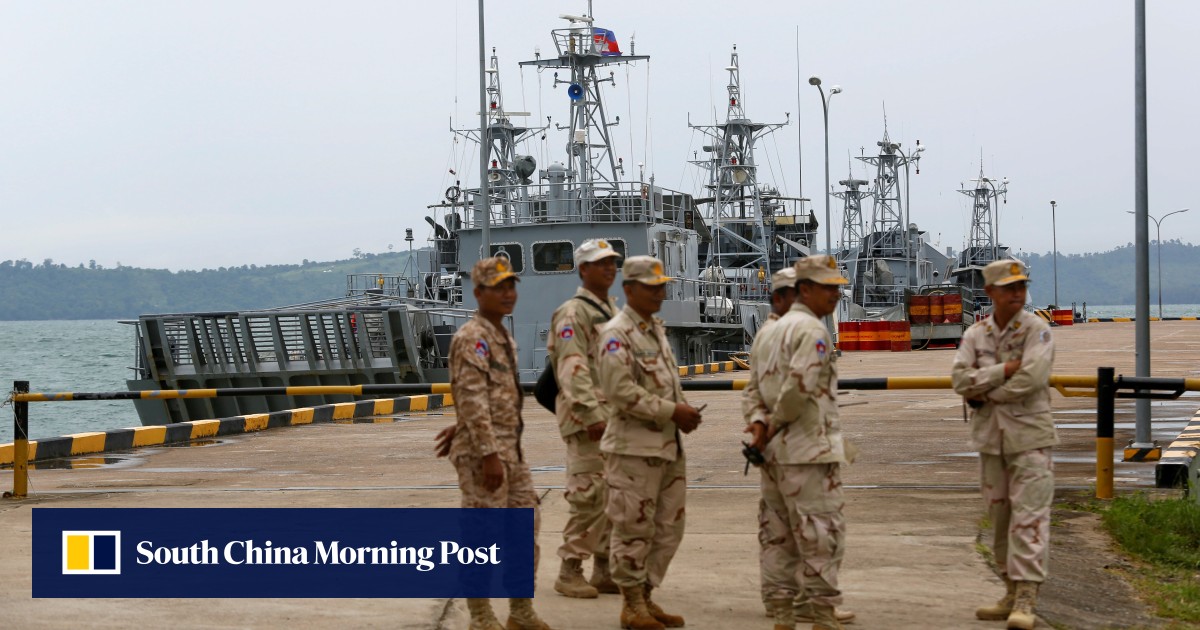- A new port and a ship repair facility are likely to have been built just north of where US-funded facilities were demolished last year, a think tank says
- US Deputy Secretary of State Wendy Sherman is visiting the Southeast Asian nation, which counts Beijing as a close ally, as part of an Asean tour
The Asia Maritime Transparency Initiative (AMTI), which is part of the Centre for Strategic and International Studies, said in a report released on May 21 and updated on May 28 that the new buildings appeared to have been completed just days before US Deputy Secretary of State Wendy Sherman was due to visit the Southeast Asian country.
AMTI said satellite imagery indicated that land clearing began sometime after April 17, construction started in early May, and the structures were completed by May 21. The expansions likely included a newly dredged port and a ship repair facility built, it added.
“The breakneck pace of construction at Ream [and] lack of transparency … continue to fuel suspicions that the upgrades there are intended for China’s benefit as much as Cambodia’s,” the report said. “And those worries will likely be high on the list of issues raised by Deputy Secretary Sherman in Phnom Penh.”
Sherman is expected to visit Phnom Penh and meet Prime Minister Hun Sen on Tuesday during an 11-day tour that will also take her to Brussels, Ankara, Jakarta, Bangkok and Honolulu.
Last year, satellite images showed that a US-funded facility at the naval base had been torn down, prompting anxieties – especially in Washington – that Phnom Penh would allow the Chinese military access to the site. Such concerns have been building since a report last year claimed China and Cambodia had signed a “secret agreement”that would permit Beijing to station military personnel, store weapons, and dock warships at the base.
These worries have persisted even though Cambodian officials have on several occasions said the demolition of the Tactical Headquarters of the National Committee for Maritime Security was unrelated to any Chinese construction plans. Rather, the officials said, it was to relocate the facility to a more suitable location that would provide more room for infrastructure expansion.
However, AMIT said in its report that the claim was hard to square with the headquarters’ new home on “tiny Koh Preab island”, adding that “recent imagery does show three new buildings going up at the site, but at a much more leisurely pace than the larger construction just completed at Ream.”
Bunna Vann, a research fellow at the Cambodian Institute for Cooperation and Peace said the construction of the new buildings under Chinese support “almost in the same area of the demolished US-built facilities indicates that China was a big motivator for Cambodia to destroy the US-sponsored buildings”.
“This would make the US more upset with Cambodia and further trouble Cambodia-US relations,” Vann said.
Sovinda Po, a senior research fellow at the Cambodian Institute for Cooperation and Peace and a PhD candidate at Australia’s Griffith University, said the timing of the project’s completion indicated that Phnom Penh was “playing a China card with the US”.
“The main purpose is to gain more leverage in its negotiation with the US,” Po said, adding that issues that would feature prominently in talks between Sherman and local officials included democracy, human rights and China’s presence in Cambodia.
“On the China issue, Phnom Penh is likely to defend its position that Cambodia has not been a Chinese proxy or client state,” he said, adding that officials would point to the country’s independent foreign policy and its constitution, which does not allow its government “to be anyone’s client state”.
On the subject of democracy and human rights, Po said Phnom Penh was expected to point out that as a sovereign country, Cambodia adhered to and practised those values “with its own characteristics”.
According to Human Rights Watch, the Cambodian government has repeatedly resorted to violence against peaceful protesters, and arrested human rights defenders, journalists, opposition party members and ordinary citizens for peacefully expressing their opinions.
Po said Cambodia had repeatedly been seen as “courting China” without taking Washington’s concerns into consideration, which “makes the US feel uncomfortable”.
Earlier this month, Cambodian Prime Minister Hun Sen – speaking at an international conference on the future of Asia – asked on whom he could rely if he did not turn to China.
Cambodia’s Ministry of Commerce last week noted that Sino-Cambodian trade volumes came to US$3 billion in the first four months of this year, up 19.7 per cent from the same period last year, while its exports to China reached US$424 million during the January to April period this year, an increase of 42 per cent. During the visit to Southeast Asia, US Deputy Secretary of State Sherman will reaffirm Washington’s commitment to Aseancentrality and address bilateral and regional issues, including efforts to urge
Myanmar’s military to cease violence. Po from the Cambodian Institute for Cooperation and Peace said Sherman’s visit would provide the US and Cambodia an opportunity to understand each other, but added that “there is no sign that this low-level visit would solve their problems”.
Vann said amid pressure from Western governments on the deterioration of democracy and human rights in Cambodia, the Hun Sen administration strongly depended on Beijing not just for economic development but also to remain in power. He added that the lack of transparency over the rapid construction at the naval base was strategically risky for Cambodia, adding that it was not usual that one country allowed another to help build a military base or constructions. “In the worst-case scenario, it would put Cambodia into the battleground of the US-China geopolitical rivalry,” Vann said.

Cambodia’s Ream Naval Base upgrade sparks worries of China link
A new port and a ship repair facility have been built just north of where US-funded facilities were demolished last year, a Washington-based think tank says.

